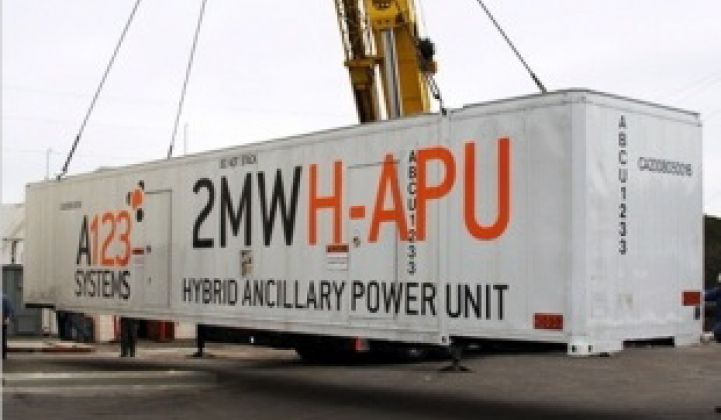Struggling lithium-ion battery maker A123 filed for bankruptcy protection on Tuesday, putting the status of its proposed $465 million bailout by China's Wanxiang -- as well as its $249 million in federal loans -- in question.
The Waltham, Mass.-based company also said it planned to sell its automotive battery business to Johnson Controls for $125 million, though the deal could be subject to competing bids in the bankruptcy process.
That move, announced on A123’s website, would appear to put an end to a proposal from Chinese auto parts giant Wanxiang Group Corp. to invest $465 million in A123, which would have given it an 80-percent stake in the company. A123 announced Monday that it had missed a debt payment to Wanxiang and Tuesday's announcement of a deal with Johnson Controls would leave other buyers with only A123's grid-scale storage and small-scale consumer electronics businesses.
Tuesday’s filing in U.S. Bankruptcy Court for the District of Delaware marks a sorry end for the Massachusetts Institute of Technology spin-out and would-be U.S. lithium-ion battery powerhouse. A123 has been fighting for survival after a $67 million recall of its automotive batteries and problems for key battery customer Fisker Automotive.
A123 got a $249 million DOE grant, along with $100 million in state tax credits, to build its battery plant in Livonia, Michigan. That has opened it up to attacks from political opponents of the Obama administration’s multi-billion-dollar green energy programs, calling the deal a giveaway of taxpayer money. Tuesday’s bankruptcy filing will no doubt increase those attacks, adding it to a long list of companies that received federal funds only to declare bankruptcy later on -- the best known example being solar company Solyndra.
At the same time, A123 is not Solyndra, which has sold off its factories for pennies on the dollar. In particular, the potential for Milwaukee, Wisc.-based Johnson Controls to take over A123's automotive battery assets and IP, which include in-development, next-generation battery chemistries as well as controls and software smarts, is a welcome sign.
Indeed, the Information Technology and Innovation Foundation, a nonprofit founded and chaired by former Republican lawmakers, praised the role of federal funding for green technology in a Tuesday statement on A123's bankruptcy, calling it not a failure of the model but an indication of "how far U.S. advanced battery innovation has come and how much farther it has to go to become globally competitive."
Asia dominates the world's advanced battery markets today. LG Chem produces batteries for the Chevy Volt and the Opel Ampera, the EU version of the Volt, while Leaf batteries are assembled by Automotive Energy Supply Corporation (AESC), a joint venture between Nissan, NEC and NEC Energy Devices. A123 is an investor and battery supplier to Fisker Automotive (A123 lost the Volt contract to LG). Tesla's Model S uses batteries and battery packs from Panasonic. Earlier this year, Sony declared that it will produce lithium-ion batteries for electric vehicles and start selling them by the middle of the decade. U.S.-based lithium-ion maker Boston-Power is both building batteries in China and selling them to Chinese automaker Beijing Electric Vehicle Co.
A123 customers include Fisker Automotive, General Motors, BMW, SAIC Motor Corp., Tata Motors and Smith Electric Vehicles. A123’s battery defects did end up playing a role in problems for key customer Fisker, which has stopped work at its Delaware factory and faced problems meeting the terms of its own $529 million federal loan.
Transportation remains A123's most important line of business, although its grid storage business has been growing in the past year or so, with installations and orders that added up to 100 megawatts by the end of 2011, much of it in partnership with AES Energy Storage.
A123 had assets of $459.8 million and debt of $376 million as of Aug. 31, according to its bankruptcy filing. The court documents state that Fisker and AES Energy Storage were its two biggest customers, accounting for about 26 percent and 24 percent of total revenue in 2011, respectively.
A123 reported a second-quarter 2012 loss of $82.9 million, compared with a loss of $55.4 million in the same period last year. That comes on top of a $125 million loss in the first quarter, more than double the loss from the same quarter last year.



